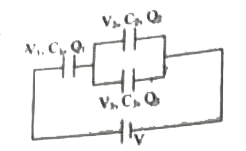Prove that magnetic moment of a hydrogen atom in its ground state is eh/4πm. Symbols have their usual meaning.
To prove that the magnetic moment M of a hydrogen atom in its ground state is given by the formula:
M=eh4πm
where e is the charge of the electron, h is Planck's constant, and m is the mass of the electron, we can follow these steps:
Step 1: Understand the Bohr Model
According to the Bohr model of the atom, the electron revolves around the nucleus in circular orbits. The angular momentum L of the electron is quantized and is given by:
L=nh2π
For the ground state, n=1, so:
L=h2π
Step 2: Express Angular Momentum in Terms of Velocity and Radius
The angular momentum L can also be expressed in terms of the mass m, velocity v, and radius r of the orbit:
L=mvr
Setting the two expressions for angular momentum equal gives:
mvr=h2π
Step 3: Solve for Velocity and Radius
From the above equation, we can express vr:
vr=h2πm
Step 4: Calculate the Current
The current I due to the revolving electron can be calculated as the charge passing through a point per unit time. The time period T for one complete revolution is given by:
T=2πrv
Thus, the current I is:
I=eT=ev2πr
Step 5: Calculate the Area of the Orbit
The area A of the circular orbit is:
A=πr2
Step 6: Calculate the Magnetic Moment
The magnetic moment M is given by:
M=I⋅A
Substituting the expressions for I and A:
M=(ev2πr)⋅(πr2)=evr2
Step 7: Substitute for vr
Now, substitute vr from Step 3 into the equation for M:
M=e2⋅(h2πm)=eh4πm
Conclusion
Thus, we have proved that the magnetic moment of a hydrogen atom in its ground state is:
M=eh4πm
According to the Bohr model of the atom, the electron revolves around the nucleus in circular orbits. The angular momentum L of the electron is quantized and is given by:
The angular momentum L can also be expressed in terms of the mass m, velocity v, and radius r of the orbit:
From the above equation, we can express vr:
The current I due to the revolving electron can be calculated as the charge passing through a point per unit time. The time period T for one complete revolution is given by:
The area A of the circular orbit is:
The magnetic moment M is given by:
Now, substitute vr from Step 3 into the equation for M:
Thus, we have proved that the magnetic moment of a hydrogen atom in its ground state is:
Topper's Solved these Questions
- BOOK - CBSE COMPLEMENTARY MATERIALCHAPTER - UNIT–III & UNIT–IV MAGNETIC EFFECTS OF CURRENT AND MAGNETISM & E.M.I. AND ALTERNATING CURRENTEXERCISE - SHORT ANSWERS QUESTIONS (3 Marks)27videos
UNIT–III & UNIT–IV MAGNETIC EFFECTS OF CURRENT AND MAGNETISM & E.M.I. AND ALTERNATING CURRENT
- BOOK - CBSE COMPLEMENTARY MATERIALCHAPTER - UNIT–III & UNIT–IV MAGNETIC EFFECTS OF CURRENT AND MAGNETISM & E.M.I. AND ALTERNATING CURRENTEXERCISE - LONG ANSWER QUESTIONS (5 Marks)5videos
UNIT–III & UNIT–IV MAGNETIC EFFECTS OF CURRENT AND MAGNETISM & E.M.I. AND ALTERNATING CURRENT
- BOOK - CBSE COMPLEMENTARY MATERIALCHAPTER - UNIT–III & UNIT–IV MAGNETIC EFFECTS OF CURRENT AND MAGNETISM & E.M.I. AND ALTERNATING CURRENTEXERCISE - (NUMERICALS)57videos
UNIT–III & UNIT–IV MAGNETIC EFFECTS OF CURRENT AND MAGNETISM & E.M.I. AND ALTERNATING CURRENT
- BOOK - CBSE COMPLEMENTARY MATERIALCHAPTER - SAMPLE QUESTION PAPER 2019EXERCISE - Section C19videos
SAMPLE QUESTION PAPER 2019
Similar Questions
Knowledge Check
- Question 1 - Select One
The ionization energy of Hydrogen atom in its ground state is……
A3.4 e VB10.2 eVC13.6 eVD– 13.6 eV - Question 2 - Select One
The ionization energy of hydrogen atom in the ground state is
A13.6 MeVB13.6 eVC13.6 JouleDZero - Question 3 - Select One
The radius of hydrogen atom, in its ground state, is of the order of
A10−8 cmB10−6 cmC10−5 cmD10−4 cm
Bohr magnetonis given by (symbols have their usual meanings)
View SolutionThe correct combination is (symbols have their usual meanings)
 View Solution
View SolutionWhen a hydrogen atom is raised the ground state to third state
View SolutionWhen a hydrogen atom is excited from ground state to first excited state then
View SolutionHydrogen atom will be in its ground state , if its electrons is in
View Solution

